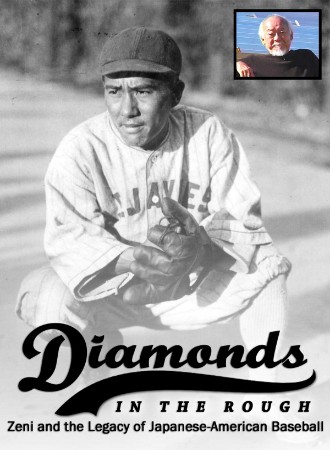
Diamonds in the Rough: Zeni and the Legacy of Japanese-American Baseball 1999
Distributed by Chip Taylor Communications, 2 East View Drive, Derry, NH 03038-4812; 800-876-CHIP (2447)
Produced by Nisei Baseball Research Project and Chip Taylor Communication
Director n/a
VHS, color and b&, 35 min., English - some Japanese with English voiceover
High School - Adult
Sports, Popular Culture, Sociology, Multicultural Studies
Date Entered: 11/09/2018
Reviewed by Orlando Archibeque, Auraria Library, University of Colorado at DenverThis is an excellent documentary video about the little-known but fascinating history of Japanese-American baseball. It focuses on the story of one man, Kenichi Zenimura (nicknamed Zeni), who is considered to be the father of Japanese-American baseball. Born in Japan in the early 1900s, he was raised in Hawaii, and later moved with his family to the Fresno, California area. Though short and thin (5 feet, 100 pounds), his athleticism, knowledge of and passion for the game, and aggressive style made him a popular figure and star of the Japanese American baseball leagues during the 1920s and 1930s, which is considered by baseball historians to be the golden era in Nisei (second generation) baseball. During this era, Japanese-American baseball leagues thrived in major cities along the Pacific coast. He became known as "The Dean of the Diamond" for his skills as a player (he played every position), and for his later successes as a coach and manager in various baseball leagues.
The mass relocation of Japanese-Americans that was implemented by President Roosevelt's Executive Order 9066 forever changed the lives of Japanese-Americans. The video's most inspiring segment is the one that deals with Zeni and his family's internment at Gila River, Arizona. He was in his early forties during the internment. After a brief period of anger and resentment, he realized that he needed to accomplish something, both for him and for his fellow internees. Working during the coolest part of the day, he and his friends built a baseball field out of the dry, barren, Arizona desert. Later it even sported a grass infield and outfield, dugouts, and bleachers. Under his guidance, he organized year-round baseball leagues that fielded more than 30 teams. Hundreds of fans came to cheer on their favorite players. Baseball brought normalcy. To those who were imprisoned, baseball was a lifesaver, both for those who played and for those who watched and supported. It is ironic that those who were considered most likely to be disloyal to the U.S. were the ones most passionately involved in the sport considered to be America's national pasttime. This theme of baseball-as-lifesaver in the internment camps is a recurring one -- Baseball Saved Us, by Ken Mochizuki (Lee & Low Books, Inc., 1993), is a good example in the children's literature genre.
The video also covers the post-war era, during which Japanese-American players played in Japan's professional leagues. And more recently, a number of players from Japan (e.g. Hideo Nomo and Hideki Irabu) are playing in U.S. Major League Baseball. This segment of the video is, unfortnately, not as interesting or enlightening as the internment segment.
Fortunately, a number of photographs and video footage of the players has survived and is being archived by the Nisei Baseball Research Project. A travelling exhibit called "Diamonds in the Rough" has been developed and is being exhibited internationally. This video successfully integrates these visual documents with the audio narration to create an informative and interesting documentary. Part of the video's success can be attributed to Noriyuki "Pat" Morita (of "Happy Days" and "Karate Kid" fame). As a former internee, he narrates with skill, empathy, and his low-key humor.
This video can be used in a variety of academic disciplines, including Sports History, Popular Culture, Sociology, and Ethnic Studies. It is recommended for media collections in public libraries and in academic media centers.